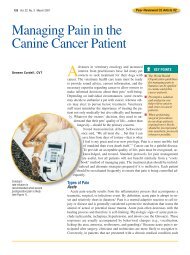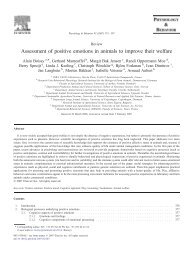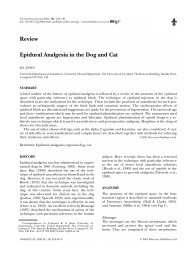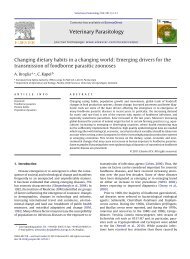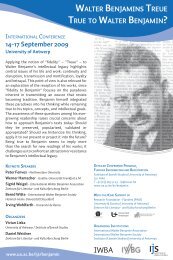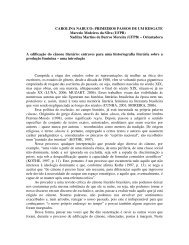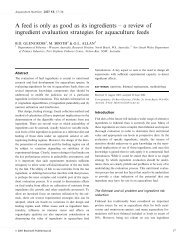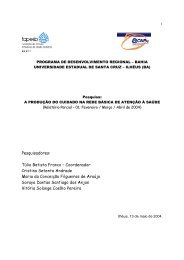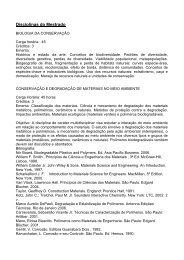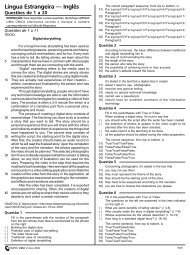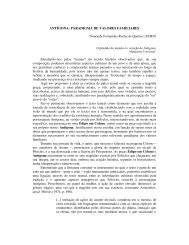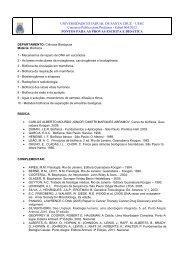saberes tradicionais e percepção ambiental dos catadores de - Uesc
saberes tradicionais e percepção ambiental dos catadores de - Uesc
saberes tradicionais e percepção ambiental dos catadores de - Uesc
Create successful ePaper yourself
Turn your PDF publications into a flip-book with our unique Google optimized e-Paper software.
CRAB CATCHERS’ TRADITIONAL KNOWLEDGE AND ENVIRONMENTAL<br />
PERCEPTION ABOUT GUAIAMUM, Cardisoma guanhumi (LATREILLE, 1825), IN<br />
THE COUNTY OF CANAVIEIRAS, BAHIA, BRAZIL.<br />
ABSTRACT<br />
This study focus on crab catchers’ empirical knowledge and environmental<br />
perceptions about guaiamum, Cardisoma guanhumi, in the county of Canavieiras,<br />
Bahia, Brazil. The main objective of this study was to <strong>de</strong>scribe the traditional<br />
knowledge of catchers about the guaiamum, focusing on their ecological knowledge<br />
about the species’ biology. This research expects to contribute to Cardisoma<br />
guanhumi preservation, and, consequently, to the welfare of human population<br />
involved in crab’s catching and/or commercialization. In or<strong>de</strong>r to achieve the main<br />
goal proposed, we present a subdivision into sub themes, as it follows: 1. social and<br />
economical characterization; 2. traditional knowledge about catching crabs; storage<br />
process; commercialization process; and consi<strong>de</strong>rations about the species.<br />
Partnerships with the Z-20 fisherman association, the NGO ECOTUBA and the<br />
Canavieiras City Hall were established. Primary data was collected related to socioeconomical<br />
characterization of the activity of catching guaiamum and its dynamic<br />
(carried out with catchers); as well as related to the storage and commercialization<br />
(carried out with catchers and owner of bars in the beach). This study has revealed<br />
the socio-economic stagnation of guaiamum’s catcher population, whose monthly<br />
income is inferior to the minimum wage. The techniques used by catchers and<br />
reported in this study were the ones called “ratoeira” and “capim”, consi<strong>de</strong>red both<br />
selective and sustainable strategies. It was noted that catchers and owners of bars in<br />
the beach were not concerned to the quality of the crab meat sold to the consumer,<br />
since the guaiamum is not submitted to a <strong>de</strong>-intoxication process while it is kept in<br />
captivity. The aim of keeping the crab in captivity is just to put in weight, while it is not<br />
commercialized. The study also noted that the presence of middleman, in more<br />
difficult access communities, had a straight influence on the prize to<br />
commercialization of guaiamum; after the negotiation between catchers and owners<br />
of beach bars, the final consumer may be charged with 200% rate over the initial<br />
value of the product. It was also noted that the catchers reveal a refined knowledge<br />
on the biology of guaiamum and the environmental phenomenon which is related to<br />
it.<br />
Keywords: Crab catchers; Guaiamum; Mangrove; Environmental perception;<br />
Cardisoma guanhumi<br />
x



